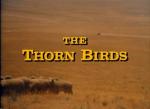

This four-part mini-series, set in Australia, covers forty-two years in the life of Ralph de Bricassart, a Roman Catholic priest who engages in a constant struggle between his calling and his carnal desires. In part one, a young Father Ralph is sent to administer a parish in outback Australia and finds himself drawn into a relationship with Mary Carson, owner of a massive sheep station. Here, too, he begins a close friendship with Carson's niece, Meggie Cleary, then a child. In part two, a bush fire destroys the Carson home and much of the station and stock. Later, having previously succumbed to their mutual passion, Father Ralph and Meggie experience an uncomfortable reunion. The politically ambitious Ralph also forms a strong and beneficial alliance with Archbishop Contini-Verchese, one of Rome's most influential religious leaders. Part three finds Meggie disillusioned after entering into an unhappy marriage. She eventually ends up working as a housemaid on a Queensland sugar-cane plantation, but later finds out that she is pregnant. The final episode, part four, covers a timespan of nearly thirty years (1935-1962) and focuses on the lives of Meggie's children, the flamboyant aspiring actress Justine and would-be priest Dane, neither of whom are initially aware of the past relationship between their mother and Father Ralph (aka Cardinal de Bricassart).